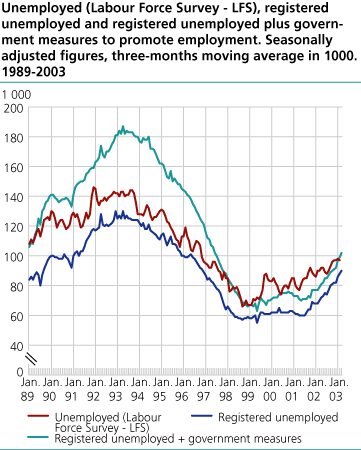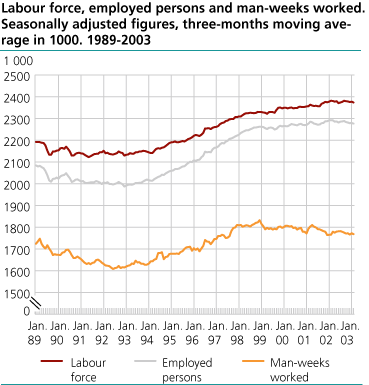Content
Published:
This is an archived release.
Unemployment over 100 000
In the first quarter 2003 unemployment was 4.4 per cent of the working force. In the same quarter 2002 it was 4.1 per cent. Over the same period the number of employed persons went down by 15 000, according to new figures from the Labour Force Surveys (LFS).
Unemployment increased
The number of unemployed persons in the first quarter 2003 was 105 000, according to the LFS. This is an increase by 8 000 from the same quarter last year. As a result, the unemployed constituted 4.4 per cent of the working force, compared with 4.1 per cent one year earlier. The unemployment has not been higher in the first quarter since 1997. Among men the unemployment was 4.8 per cent, and for women it was 4.1 per cent. The increase from the same quarter last year mainly came among people aged 25-54. All of the growth came among people wanting a full-time job.
Increased unemployment in the EU, unchanged for the OECD
The seasonally adjusted unemployment rate in Norway was unchanged between November 2002 and February 2003. In the same period the unemployment increased from 7.7 to 7.9 per cent as an average in the EU member countries. The unemployment rate in the OECD-countries as a whole was unchanged at 7.0 per cent. In February 2003 the unemployment rate amounted to 5.8 in USA, 0.1 percentage point lower than in November 2002. The unemployment rate in Denmark increased from 4.7 per cent in November 2002 to 5.0 per cent in February 2003, while it was unchanged at 5.1 per cent in Sweden, and it deceased in Finland from 9.0 to 8.8 per cent. In the same period unemployment increased both in France and Germany. This is according to figures from OECD .
More under-employed
There number of under-employed amounted to 82 000 persons in the first quarter 2003, i.e. part-time employees seeking more work. This is an increase of 8 000 from the same quarter last year. As a percentage of all part-time employed, this corresponds to 13.4 per cent, compared with 12.1 per cent in the first quarter 2002. Approximately one half of the under-employed want to work full-time.
Lower labour force participation
The labour force participation decreased for both sexes from the first quarter 2002 to the first quarter 2003. Nearly 69 per cent of the women aged 16-74 were participating in the labour force, compared to 76 per cent of the men. The overall labour force participation has not been lower in the first quarter since 1997.
Employment decreased
The number of employees went down by 15 000 from the first quarter 2002 to the first quarter 2003. Of the main industries, transport and communication had the largest decrease - 12 000.
Less temporary employment
185 000 persons were temporary employed in the first quarter 2003, 7 000 less than in the same quarter 2002. This corresponds to 8.8 per cent of all employees in the first quarter 2003, compared with 9.1 per cent one year before. The rate of temporary employment was highest in health and social work, education, and hotels and restaurants. In the opposite end we find manufacturing and construction.
|
Seasonally adjusted figures: The labour market continues weakening
The number of employed persons went down by 5 000 from the three-month-period of October-December 2002 to January-Mars 2003, according to seasonally adjusted figures from the LFS. Over the same period the unemployment figures decreased by 1 000. However, this is within the margin of errors derived from the selection uncertainty of the LFS. Thus, the reduction is not inconsistent with the more long-term trend of increasing unemployment as shown by the LFS. The method of seasonally adjusting makes us more able to reveal the current development in the labour market, as an alternative to compare with the same quarter in the last year. Seasonally adjusted figures are presented in a separate article. |
Tables:
- Table 1. Population aged 16-74 in the labour force, man-weeks worked, registered unemployed persons and persons employed by government measures. 1000 and per cent
- Table 2. Population aged 16-74 år in the labour force, employed persons and unemployed persons by sex (LFS). 1000 and per cent
- Table 3. Persons in the labour force and employed persons by age and sex (LFS). 1 000 and per cent
- Table 4. Population aged 16-74, employed persons by settled/usual working hours per week(1) and unemployed persons by age and sex (LFS). 1000
- Table 5. Persons in the labour force by age and sex. 1000 and as per cent of all in each group
- Table 6. Employed persons by sex and settled/usual working hours per week (LFS). 1 000
- Table 7. Population aged 16-74 by main activity, part-time employment and age (LFS). 1 000
- Table 8. Employed persons by major industry division. 1000
- Table 9. Number of man-hours worked per week by industry division (LFS). 1 000
- Table 10. Employed persons, total, and employed persons at work by status and sex. Number of man-hours worked and actual working hours per week (LFS)
- Table 11. Population aged 16-74, employed persons, temporary absence from work and reason for absence, by sex(1). 1000 and per cent
- Table 12. Employees with temporary jobs, by major industry division (LFS). 1000 and as per cent of all employees
- Table 13. Unemployed persons by sex and age (LFS). 1000 and per cent
- Table 14. Unemployed persons by duration of job search (LFS). 1000 and per cent
- Table 15. Unemployed persons by main activity (LFS). 1 000
- Table 16. Unemployed and underemployed persons, by sex and desired working hours per week. Number of man-weeks (of 37,5 hours) supplied (LFS). 1000
- Table 17. Persons aged 16-74 years by labour force status, seasonally adjusted, three-months moving average. 1000
- Table 18. Persons in the labour force by sex and region (LFS). 1 000 and in per cent of total
- Table 19. Employed persons by sex and region (LFS). 1 000
- Table 20. Employed persons by sex and regions (LFS) as per cent of all in each group
- Table 21 Employed persons, by some major industry division and region (LFS). 1997-2002. 1 000
Contact
-
Arbeidsmarked og lønn
E-mail: arbeidsmarked@ssb.no
-
Erik Herstad Horgen
E-mail: erik.horgen@ssb.no
tel.: (+47) 93 08 68 62
-
Håvard Hungnes Lien
E-mail: havard.lien@ssb.no
tel.: (+47) 40 90 26 06


